Process of Natural Gas Explosion in Linked Vessels with Three Structures Obtained Using Numerical Simulation
Abstract
:1. Introduction
2. Simulation Objects
2.1. Experimental Apparatus and Geometric Model
2.2. Boundary Conditions and Initial Conditions
3. Simulation Results with Different Structures
3.1. Simulation Results in the Single Spherical Vessel
3.1.1. Influence of Vessel Size on the Explosion Pressure
3.1.2. Simulation Results of the Explosion Parameters in the Single Vessel
3.2. Simulation Results in for Single Vessel with Pipes Connected to IT
3.2.1. Simulation Results of the Explosion Parameters in the Single Vessel with Pipes Connected to It
3.2.2. Influence of Changing the Ignition Position
3.2.3. Influence of the Length of the Connection Pipes
3.3. Simulation Results of the Big Vessel Connected to the Small Vessel
3.3.1. Simulation Results of the Explosion Parameters in the Big Vessel Connected to the Small Vessel
3.3.2. How Changing the Ignition Position Influenced the Gas Explosion
3.3.3. How Changing the Length of the Connection Pipe Influenced the Gas Explosion
4. Error Analysis
5. Conclusions
- When the explosions occurred in the same initial conditions, the peak explosion pressure maintained unchanged. However, the maximum rate of pressure rise decreased when the volume of the closed vessels increased, which is following the explosion cubic law.
- The length of the connecting pipe profoundly affected the explosion intensity in the single vessel with a pipe connected to it and in the big vessel connected to the small vessel. Furthermore, an oscillation of the explosion wave developed in the linked vessels.
- The ignition position affected the explosion intensity in the linked system extremely. The explosion intensity was weakest when the ignition source was positioned at the center of the system.
- When the explosions occurred in the linked system, the explosion intensities in the secondary vessels were stronger than those in the initiating vessels.
- Using FLACS software for the simulation of the small–scale linked system, the average difference attained 6.97%. Accordingly, the simulation results agreed reasonably well with the experimental results and the actual explosion conditions were reflected in the FLACS simulation to an acceptable extent.
Author Contributions
Funding
Conflicts of Interest
References
- Kundu, S.K. Understanding and eliminating pressure fluctuations in an extended chlor-alkali plant due to the size detail of seal pots: A design correlation. Process Saf. Environ. Prot. 2010, 88, 91–96. [Google Scholar] [CrossRef]
- Ni, T.W.; Bi, T.T.; Yang, Z.G. Failure analysis on abnormal perforation of super large diameter buried gas pipeline nearby metro. Eng. Fail. Anal. 2019, 103, 32–43. [Google Scholar] [CrossRef]
- Chen, C.H.; Sheen, Y.N.; Wang, H.Y. Case analysis of catastrophic underground pipeline gas explosion in Taiwan. Eng. Fail. Anal. 2016, 65, 39–47. [Google Scholar] [CrossRef]
- Yin, W.; Fu, G.; Yang, C.; Jiang, Z.; Zhu, K.; Gao, Y. Fatal gas explosion accidents on Chinese coal mines and the characteristics of unsafe behaviors: 2000–2014. Saf. Sci. 2017, 92, 173–179. [Google Scholar] [CrossRef]
- Zhao, X.; Chunming, J.; Yanping, W.; Jiwu, Y.; Zheng, W. Simulation study on an explosion accident in China. Process Saf. Prog. 2014, 33, 56–63. [Google Scholar] [CrossRef]
- Wang, Z.R.; Pan, M.Y.; Jiang, J.C. Experimental investigation of gas explosion in single vessel and connected vessels. J. Loss Prev. Process Ind. 2013, 26, 1094–1099. [Google Scholar] [CrossRef]
- Zhang, K.; Wang, Z.; Chen, Z.; Jiang, F.; Wang, S. Influential factors of vented explosion position on maximum explosion overpressure of methane-air mixture explosion in single spherical container and linked vessels. Process Saf. Prog. 2018, 37, 248–255. [Google Scholar] [CrossRef]
- Kindracki, J.; Kobiera, A.; Rarata, G.; Wolanski, P. Influence of ignition position and obstacles on explosion development in methane-air mixture in closed vessels. J. Loss Prev. Process Ind. 2007, 20, 551–561. [Google Scholar] [CrossRef]
- Zuo, Q.; Wang, Z.; Zhen, Y.; Zhang, S.; Cui, Y.; Jiang, J. The Effect of an Obstacle on Methane-Air Explosions in a Spherical Vessel Connected to a Pipeline. Process Saf. Prog. 2016, 36, 1–7. [Google Scholar] [CrossRef]
- Zhang, K.; Wang, Z.; Ni, L.; Cui, Y.; Zhen, Y.; Cui, Y. Effect of one obstacle on methane–air explosion in linked vessels. Process Saf. Environ. Prot. 2016, 105, 217–223. [Google Scholar] [CrossRef]
- Zhang, K.; Wang, Z.; Gong, J.; Liu, M.; Dou, Z.; Jiang, J. Experimental study of effects of ignition position, initial pressure and pipe length on H2-air explosion in linked vessels. J. Loss Prev. Process Ind. 2017, 50, 295–300. [Google Scholar] [CrossRef]
- Na’inna, A.M.; Phylaktou, H.N.; Andrews, G.E. Explosion flame acceleration over obstacles: Effects of separation distance for a range of scales. Process Saf. Environ. Prot. 2017, 107, 309–316. [Google Scholar] [CrossRef] [Green Version]
- Cui, Y.; Wang, Z.; Jiang, J.; Liu, X. Size effect on explosion intensity of methane-air mixture in spherical vessels and pipes. Procedia Eng. 2012, 45, 483–488. [Google Scholar] [CrossRef] [Green Version]
- Zhang, K.; Wang, Z.; Yan, C.; Cui, Y.; Dou, Z.; Jiang, J. Effect of size on methane-air mixture explosions and explosion suppression in spherical vessels connected with pipes. J. Loss Prev. Process Ind. 2017, 49, 785–790. [Google Scholar] [CrossRef]
- Zhang, B.; Bai, C.; Xiu, G.; Liu, Q.; Gong, G. Explosion and flame characteristics of methane/air mixtures in a large-scale vessel. Process Saf. Prog. 2014, 33, 362–368. [Google Scholar] [CrossRef]
- Yu, M.; Wan, S.; Zheng, K.; Guo, P.; Chu, T.; Wang, C. Effect of side venting areas on the methane/air explosion characteristics in a pipeline. J. Loss Prev. Process Ind. 2018, 54, 123–130. [Google Scholar] [CrossRef]
- Wan, S.; Yu, M.; Zheng, K.; Wang, C.; Yuan, Z.; Yang, X. Effect of side vent size on a methane/air explosion in an end-vented duct containing an obstacle. Exp. Therm. Fluid Sci. 2019, 101, 141–150. [Google Scholar] [CrossRef]
- Cui, Y.Y.; Wang, Z.R.; Ma, L.S.; Zhen, Y.Y.; Sun, W. Influential factors of gas explosion venting in linked vessels. J. Loss Prev. Process Ind. 2017, 46, 108–114. [Google Scholar] [CrossRef]
- Di Benedetto, A.; Salzano, E. CFD simulation of pressure piling. J. Loss Prev. Process Ind. 2010, 23, 498–506. [Google Scholar] [CrossRef]
- Di Benedetto, A.; Salzano, E.; Russo, G. Predicting pressure piling by semi-empirical correlations. Fire Saf. J. 2005, 40, 282–298. [Google Scholar] [CrossRef]
- Phylaktou, H.; Andrews, G.E. Gas explosions in linked vessels. J. Loss Prev. Process Ind. 1993, 6, 15–19. [Google Scholar] [CrossRef]
- Zhang, Q.; Jiang, J.; You, M.; Yu, Y.; Cui, Y. Experimental study on gas explosion and venting process in interconnected vessels. J. Loss Prev. Process Ind. 2013, 26, 1230–1237. [Google Scholar] [CrossRef]
- Singh, J. Gas explosions in inter-connected vessels: Pressure piling. Process Saf. Environ. Prot. Trans. Inst. Chem. Eng. Part B 1994, 72, 220–228. [Google Scholar]
- Maremonti, M.; Russo, G.; Salzano, E.; Tufano, V. Numerical simulation of gas explosions in linked vessels. J. Loss Prev. Process Ind. 1999, 12, 189–194. [Google Scholar] [CrossRef]
- Deng, J.; Cheng, F.; Song, Y.; Luo, Z.; Zhang, Y. Experimental and simulation studies on the influence of carbon monoxide on explosion characteristics of methane. J. Loss Prev. Process Ind. 2015, 36, 45–53. [Google Scholar] [CrossRef]
- Ferrara, G.; Willacy, S.K.; Phylaktou, H.N.; Andrews, G.E.; Di Benedetto, A.; Salzano, E.; Russo, G. Venting of gas explosion through relief ducts: Interaction between internal and external explosions. J. Hazard. Mater. 2008, 155, 358–368. [Google Scholar] [CrossRef]
- Di Sarli, V.; Di Benedetto, A.; Russo, G. Using Large Eddy Simulation for understanding vented gas explosions in the presence of obstacles. J. Hazard. Mater. 2009, 169, 435–442. [Google Scholar] [CrossRef]
- GexCon, A.S. FLACS V10.3 User’s Manual; GexCon AS: Bergen, Norway, 2014. [Google Scholar]
- Bleyer, A.; Taveau, J.; Djebaïli-Chaumeix, N.; Paillard, C.E.; Bentaïb, A. Comparison between FLACS explosion simulations and experiments conducted in a PWR Steam Generator casemate scale down with hydrogen gradients. Nucl. Eng. Des. 2012, 245, 189–196. [Google Scholar] [CrossRef]
- Middha, P.; Hansen, O.R.; Grune, J.; Kotchourko, A. CFD calculations of gas leak dispersion and subsequent gas explosions: Validation against ignited impinging hydrogen jet experiments. J. Hazard. Mater. 2010, 179, 84–94. [Google Scholar] [CrossRef]
- Luo, Z.M.; Zhang, Q.; Hua, W.; Cheng, F.M.; Tao, W.; Deng, J. Numerical simulation of gas explosion in confined space with FLACS. J. China Coal Soc. 2013, 38, 1381–1387. (In Chinese) [Google Scholar]
- Bartknecht, W. Dust Explosions: Course, Prevention, Protection; Springer Science & Business Media: Berlin, Germany, 2012; ISBN 3642739458. [Google Scholar]
- Ivanov, A.G. Dynamic fracture and scale effects (survey). J. Appl. Mech. Tech. Phys. 1994, 35, 430–442. [Google Scholar] [CrossRef]
- Wang, Z.R.; Jiang, J.C.; Zhou, C. Experimental investigation of gas explosion characteristic in linked vessels. Explos Shock Wave 2011, 31, 69–74. (In Chinese) [Google Scholar]


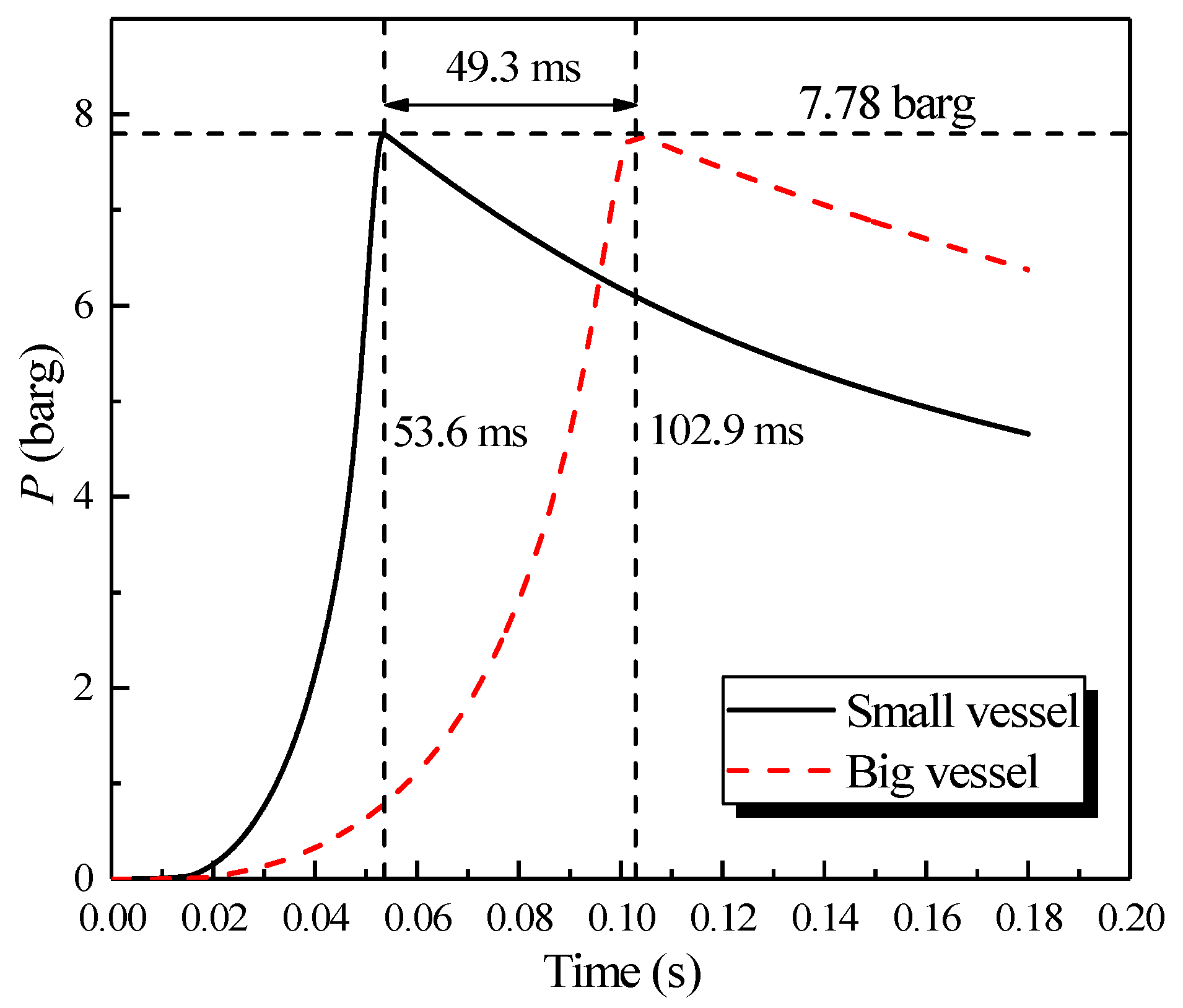
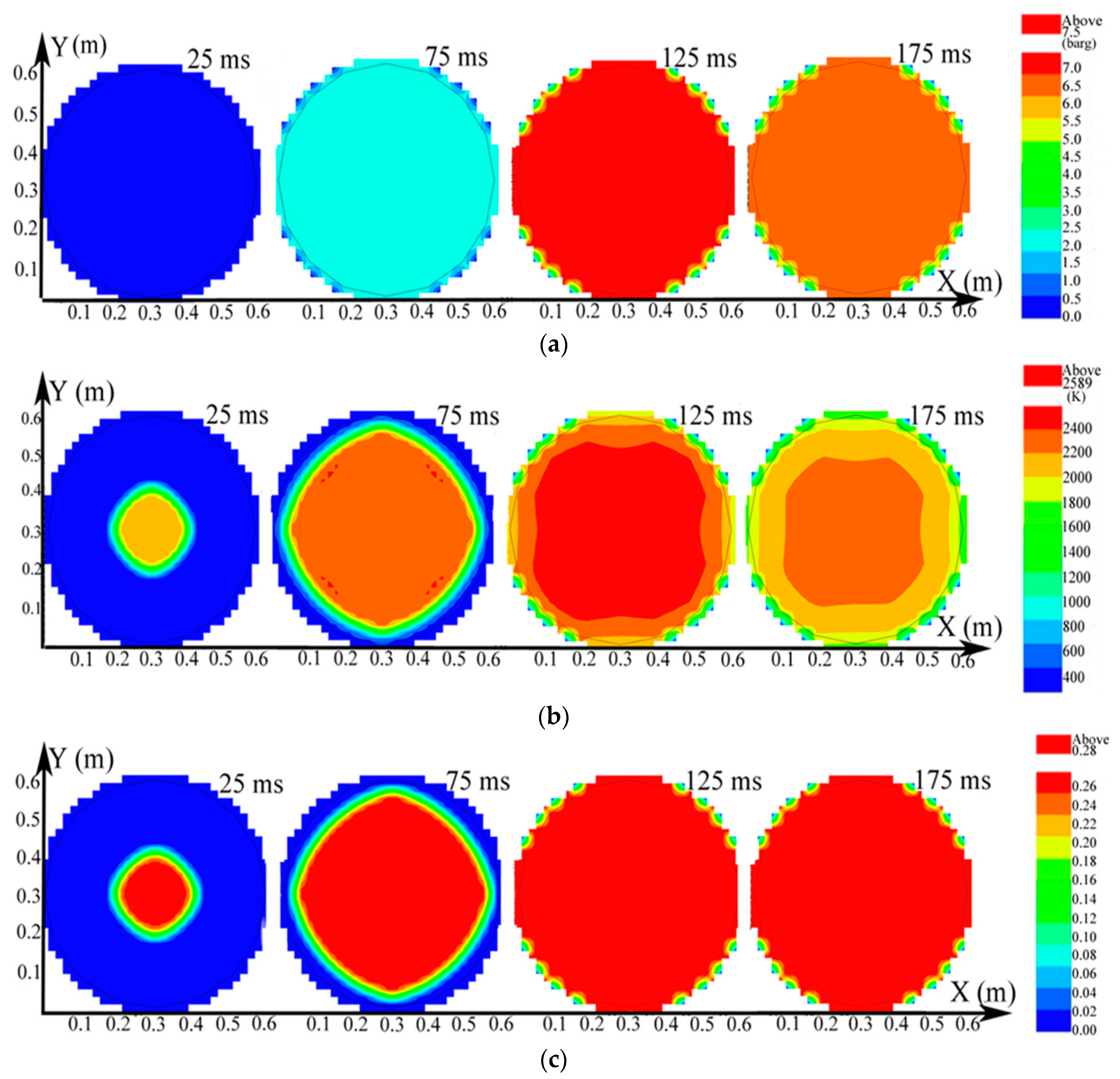

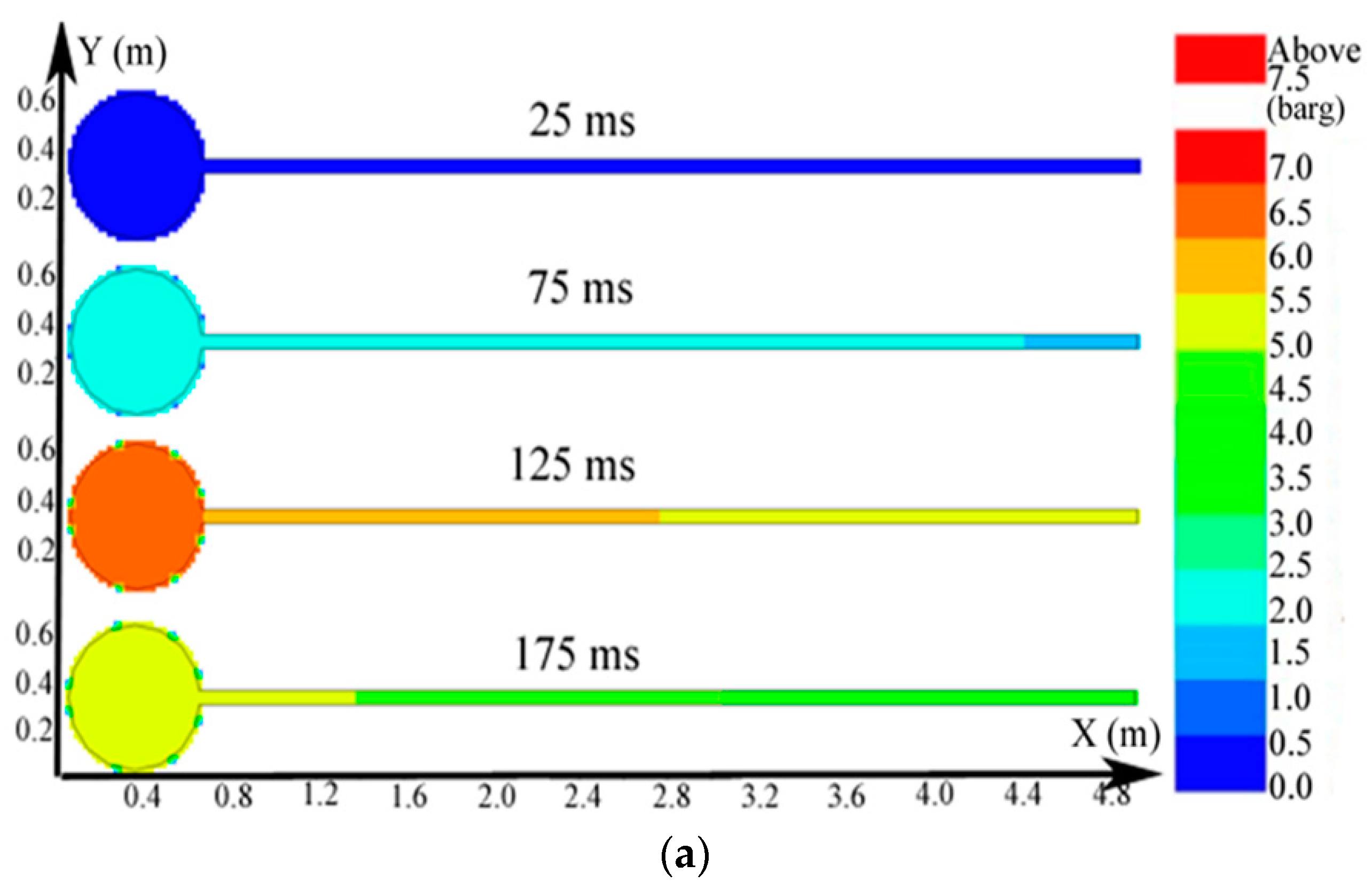
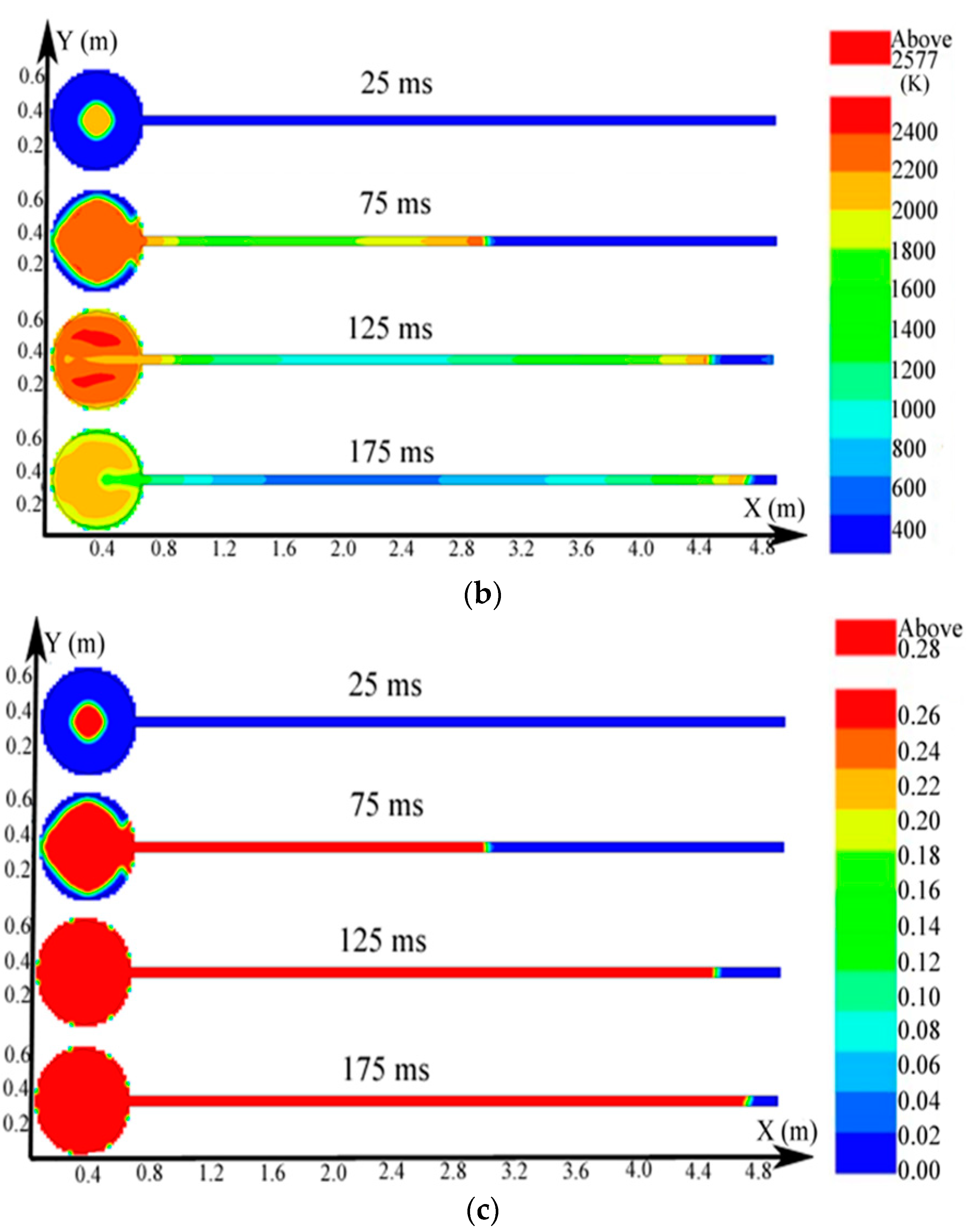
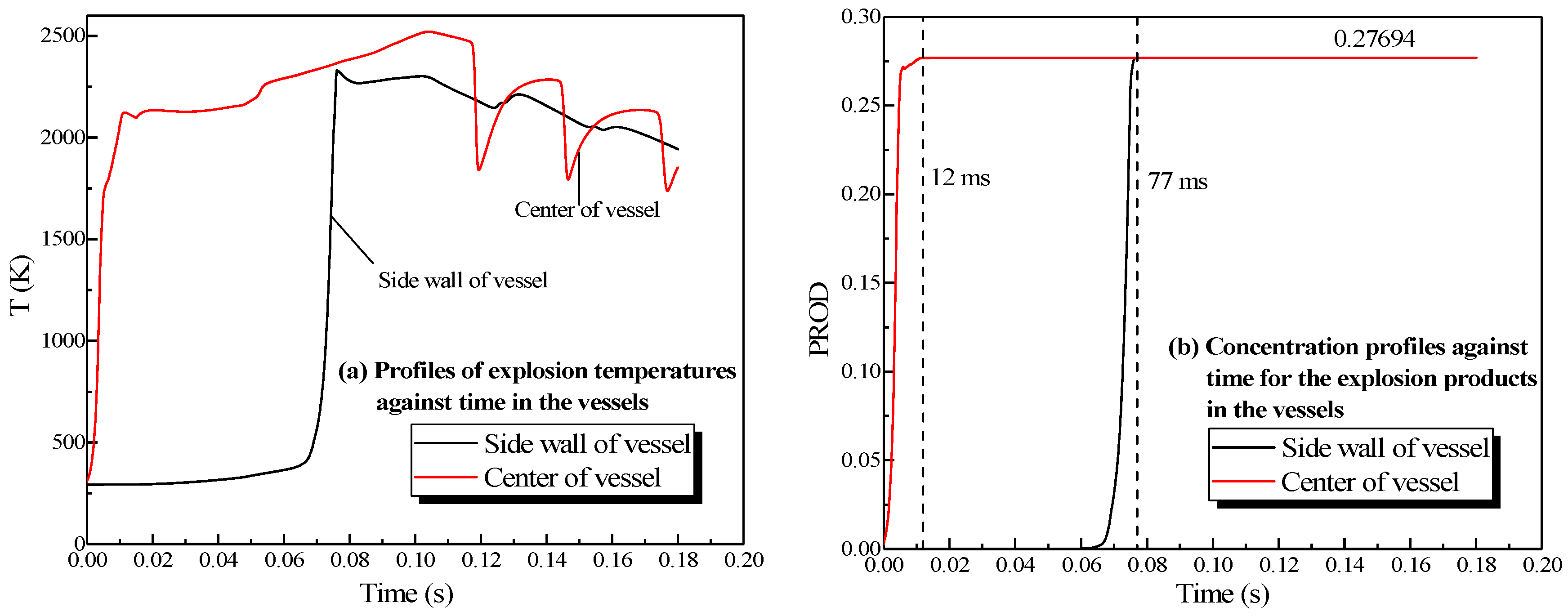

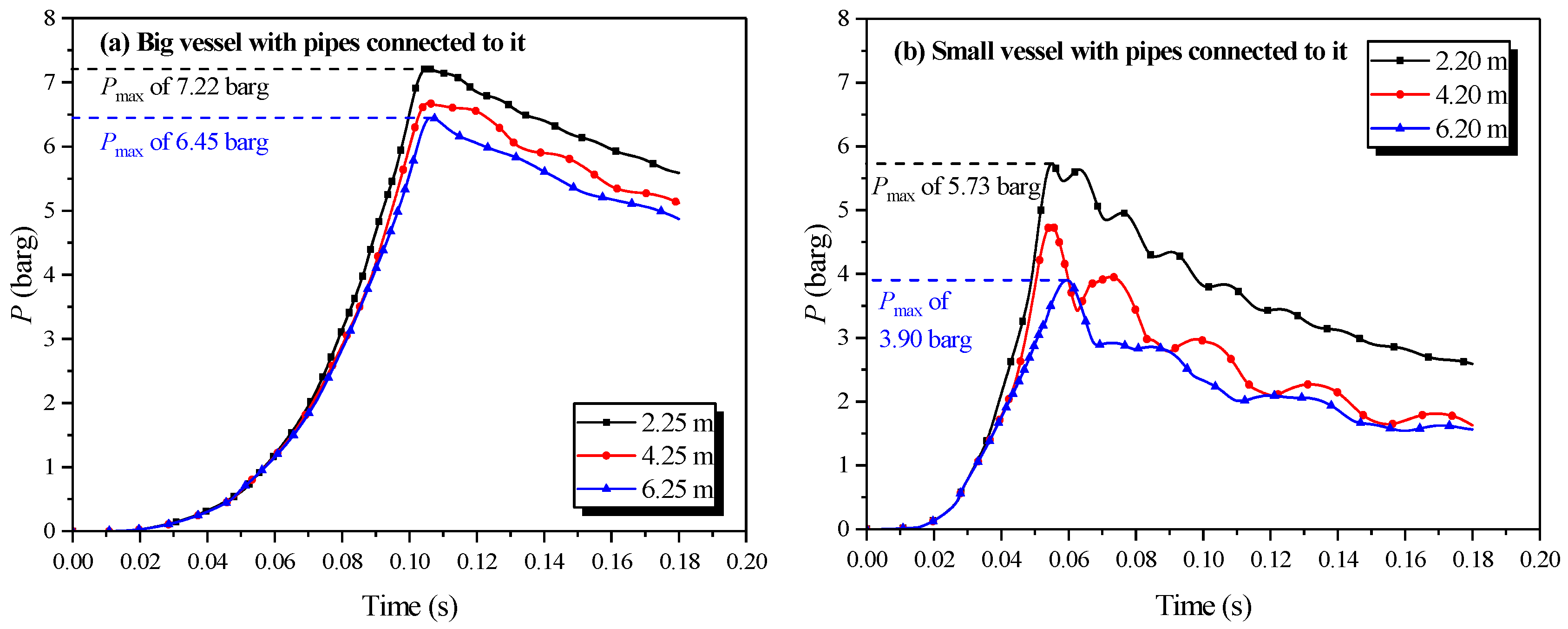


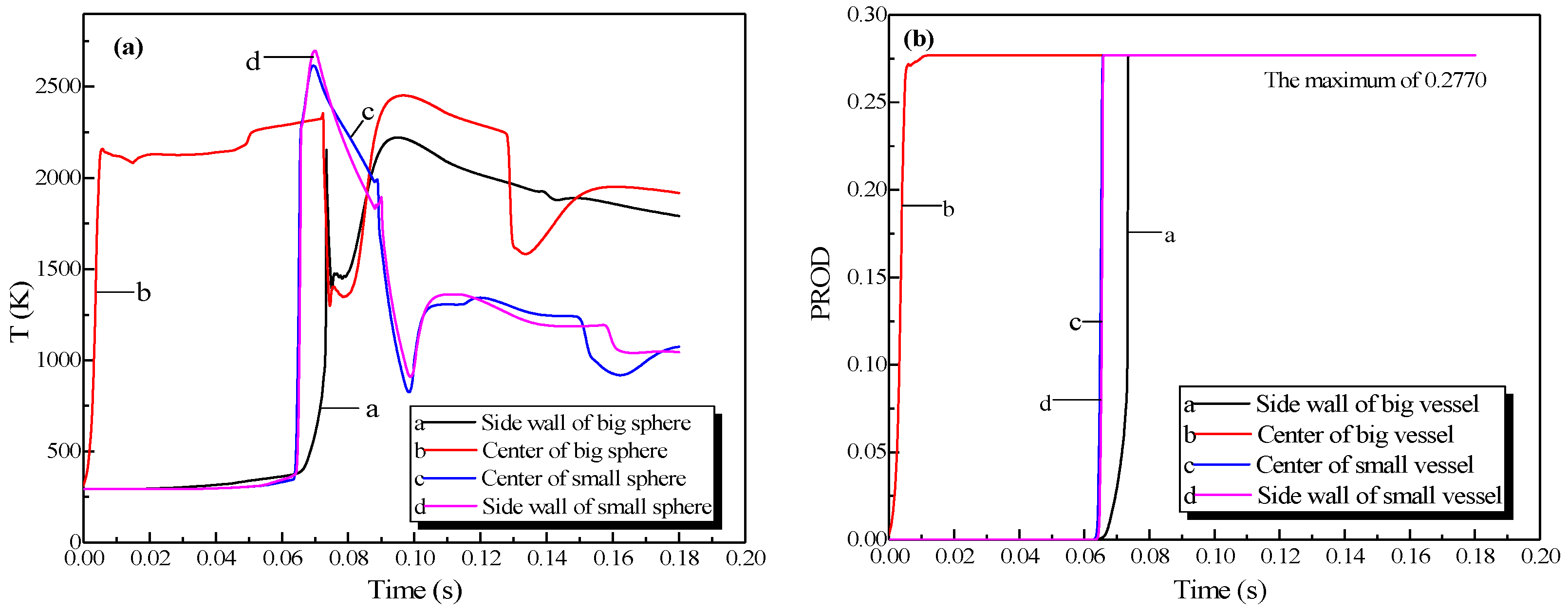

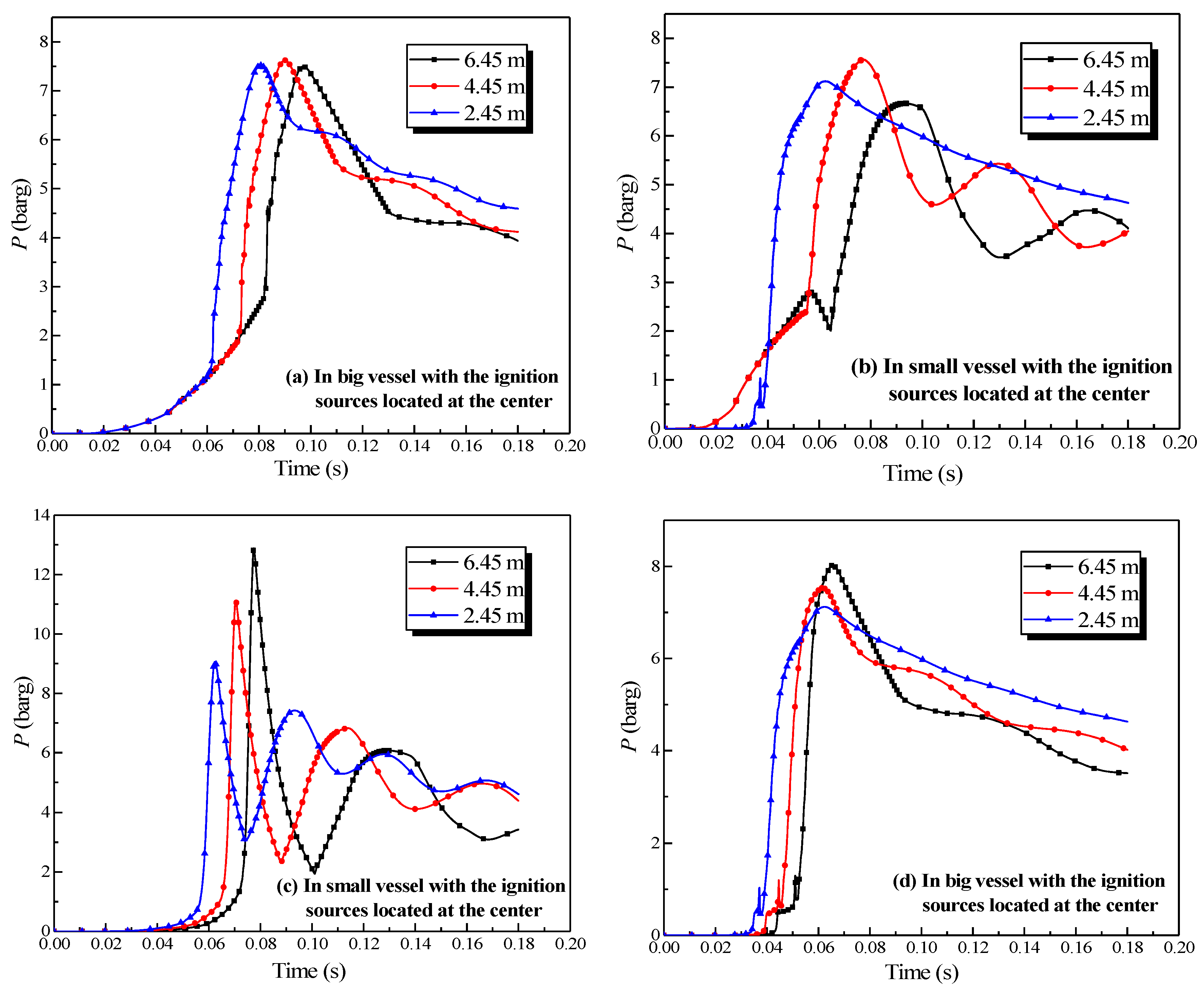

© 2020 by the authors. Licensee MDPI, Basel, Switzerland. This article is an open access article distributed under the terms and conditions of the Creative Commons Attribution (CC BY) license (http://creativecommons.org/licenses/by/4.0/).
Share and Cite
Wang, Q.; Sun, Y.; Li, X.; Shu, C.-M.; Wang, Z.; Jiang, J.; Zhang, M.; Cheng, F. Process of Natural Gas Explosion in Linked Vessels with Three Structures Obtained Using Numerical Simulation. Processes 2020, 8, 52. https://doi.org/10.3390/pr8010052
Wang Q, Sun Y, Li X, Shu C-M, Wang Z, Jiang J, Zhang M, Cheng F. Process of Natural Gas Explosion in Linked Vessels with Three Structures Obtained Using Numerical Simulation. Processes. 2020; 8(1):52. https://doi.org/10.3390/pr8010052
Chicago/Turabian StyleWang, Qiuhong, Yilin Sun, Xin Li, Chi-Min Shu, Zhirong Wang, Juncheng Jiang, Mingguang Zhang, and Fangming Cheng. 2020. "Process of Natural Gas Explosion in Linked Vessels with Three Structures Obtained Using Numerical Simulation" Processes 8, no. 1: 52. https://doi.org/10.3390/pr8010052



